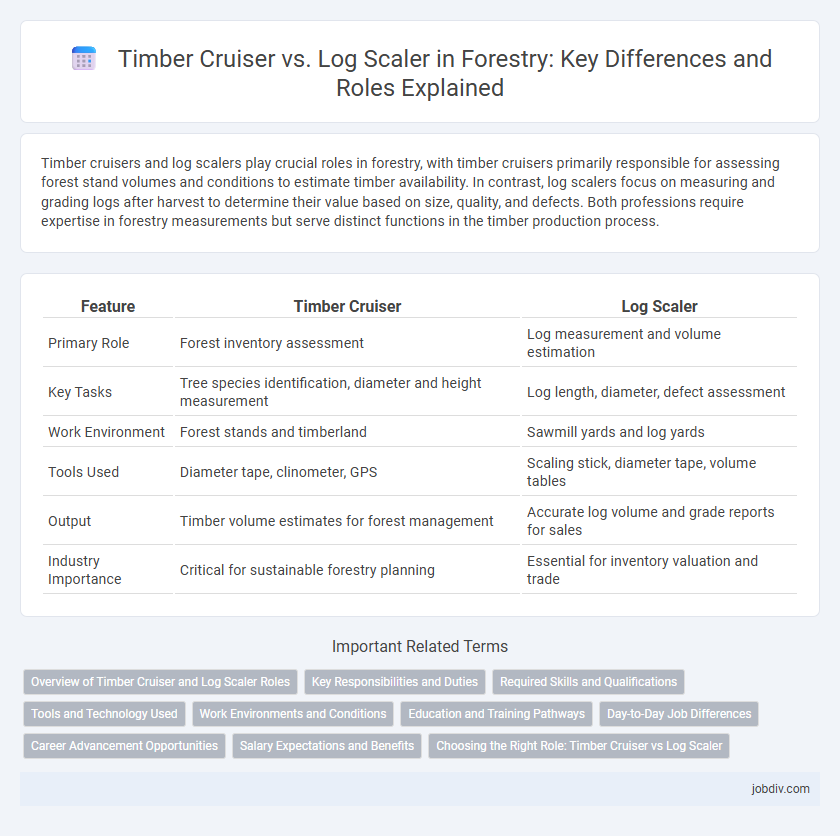Timber cruisers and log scalers play crucial roles in forestry, with timber cruisers primarily responsible for assessing forest stand volumes and conditions to estimate timber availability. In contrast, log scalers focus on measuring and grading logs after harvest to determine their value based on size, quality, and defects. Both professions require expertise in forestry measurements but serve distinct functions in the timber production process.
Table of Comparison
| Feature | Timber Cruiser | Log Scaler |
|---|---|---|
| Primary Role | Forest inventory assessment | Log measurement and volume estimation |
| Key Tasks | Tree species identification, diameter and height measurement | Log length, diameter, defect assessment |
| Work Environment | Forest stands and timberland | Sawmill yards and log yards |
| Tools Used | Diameter tape, clinometer, GPS | Scaling stick, diameter tape, volume tables |
| Output | Timber volume estimates for forest management | Accurate log volume and grade reports for sales |
| Industry Importance | Critical for sustainable forestry planning | Essential for inventory valuation and trade |
Overview of Timber Cruiser and Log Scaler Roles
Timber Cruisers assess forest stands by estimating volume, species composition, and tree quality through sample plots, providing crucial data for forest management and harvesting plans. Log Scalers measure and grade individual logs based on size, defects, and market specifications to determine their value and suitability for processing. Both roles require expertise in timber measurement, but Timber Cruisers focus on forest inventory while Log Scalers specialize in log valuation and quality assessment.
Key Responsibilities and Duties
Timber Cruisers are primarily responsible for assessing forest stands by measuring tree volume, species composition, and growth rates to estimate timber resources accurately. Log Scalers specialize in evaluating harvested logs, determining log quality, dimensions, and defects to classify and grade timber for sale or processing. Both roles require proficiency in forestry measurement techniques but differ in field versus post-harvest evaluation settings.
Required Skills and Qualifications
Timber Cruisers require strong skills in forest measurement, navigation, and data collection, often utilizing GPS technology and compasses to estimate timber volume accurately. Log Scalers must possess expert knowledge in wood species identification, log grading, and precise measurement techniques to assess the commercial value of timber effectively. Both roles demand proficiency in using forestry tools and adherence to industry standards, with log scalers typically requiring certification or licensing due to the financial implications of their evaluations.
Tools and Technology Used
Timber cruisers employ advanced GPS devices, laser rangefinders, and electronic data recorders to efficiently estimate timber volume and stand characteristics. Log scalers utilize calibrated measuring tapes, diameter tapes, digital calipers, and specialized software for precise log dimension measurement and volume calculation. Both roles increasingly integrate mobile applications and remote sensing technology to enhance accuracy and streamline data collection in forestry operations.
Work Environments and Conditions
Timber Cruisers operate primarily in rugged, dense forest terrains, conducting preliminary timber volume assessments often under variable weather conditions and uneven ground. Log Scalers work in more controlled environments such as log yards or processing facilities, where the focus is on precise measurement and grading of logs post-harvest. Both roles require adaptability to outdoor settings, but Timber Cruisers face more physically demanding and unpredictable field conditions compared to the relatively stable workspaces of Log Scalers.
Education and Training Pathways
Timber Cruisers typically undergo training programs that emphasize forest measurement techniques, mapping, and inventory data collection, often paired with on-the-job field experience for practical skill development. Log Scalers require specialized education focused on wood grading standards, log volume calculation, and quality assessment, often supported by certification courses from forestry organizations. Both roles benefit from continuous professional development to stay updated with industry standards and technological advancements in timber evaluation.
Day-to-Day Job Differences
Timber cruisers primarily conduct forest inventories by estimating the volume, quality, and species of timber within a designated area using sampling techniques and mapping tools. Log scalers focus on measuring and grading harvested logs at mills or landings, determining the exact volume and value based on log dimensions and quality attributes. The daily routine for timber cruisers involves extensive fieldwork and data collection in diverse forest conditions, whereas log scalers perform detailed assessments of cut timber, often working in controlled environments to ensure accuracy for sales and processing.
Career Advancement Opportunities
Timber Cruisers gain foundational skills in forest inventory and stand assessment, paving the way for specialized roles such as forest managers or harvesting supervisors. Log Scalers develop expertise in timber measurement and quality grading, enhancing prospects for positions in lumber sales, quality control, and mill operations. Progression in both careers often leads to higher earnings and leadership roles within the forestry industry.
Salary Expectations and Benefits
Timber cruisers typically earn between $40,000 and $60,000 annually, with benefits often including health insurance and seasonal bonuses, reflecting their role in forest inventory and timber volume estimation. Log scalers command higher salaries, averaging $50,000 to $70,000 per year, due to their expertise in assessing log quality and volume for commercial transactions, with benefits encompassing comprehensive health plans, retirement options, and performance incentives. Salary variations depend on geographic location, certification levels, and experience, with log scalers generally receiving more consistent year-round employment and financial perks.
Choosing the Right Role: Timber Cruiser vs Log Scaler
Timber cruisers play a crucial role in forest inventory by estimating timber volume and assessing stand conditions, while log scalers specialize in measuring and grading logs for market value and quality. Choosing the right role depends on whether the focus is on pre-harvest forest management and inventory (timber cruiser) or post-harvest log measurement and valuation (log scaler). Understanding these distinctions ensures effective forest resource management and accurate commercial timber transactions.
Timber Cruiser vs Log Scaler Infographic

 jobdiv.com
jobdiv.com